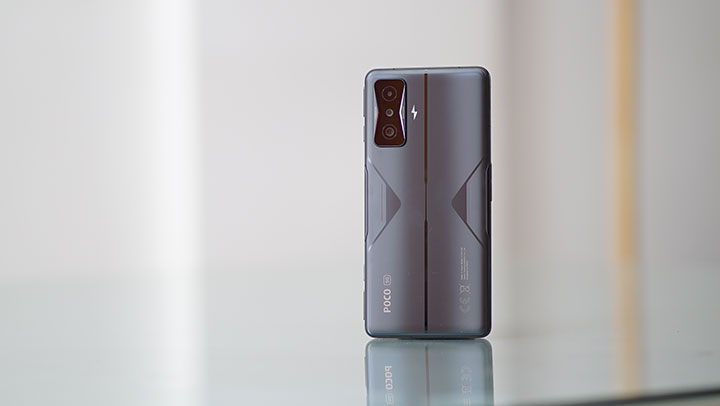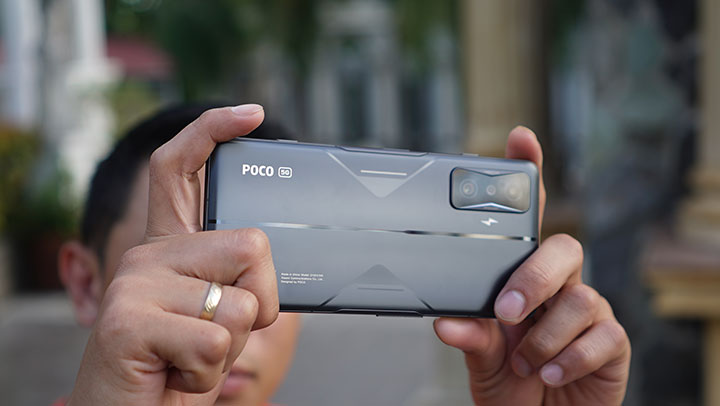Xiaomi’s POCO line of smartphones has always attracted a lot of attention for really pushing affordable yet feature-rich smartphones. With today’s announcement of the POCO F4 GT, it has once again made a strong statement by releasing a massively powerful gaming smartphone at a very affordable price point.

It’s not every day you get to see a phone running a top-notch chipset like the Snapdragon 8 Gen 1 and positioned to compete in the vicinity of other mid-range smartphones in terms of pricing. Read on why the POCO F4 GT is doing just that.
Table of Contents
POCO is trying its best to make the F4 GT look like a gaming smartphone in terms of design and we can see a little bit of that in some aspects. This look was designed in collaboration with the Mercedes-AMG F1 team (well, inspired by the Redmi K50 Gaming).
In a way, the design of the POCO F4 GT is pretty straightforward — solid aluminum chassis, glass front and back, sharp edges and a masculine look. It does scream “gaming” but not too outlandish. That Cyber Yellow color looks pretty neat though!

Even the orientation or layout of the exterior clearly hints of a landscape orientation. For instance, the placement of the quad speakers are aligned on the sides where your hands would not cover them when holding the phone with both hands. The volume control on the left side is close to the middle, just like the power button on the right side.

The dual nano-SIM card slot is on the left along with a 3rd (!) microphone optimally positioned when you want to talk with other players while in-game. The secondary microphone is up top with the IR Blaster and a set of speakers. The primary microphone (for making calls) is down below, along with the Type-C charging port and the other set of speakers.

The side-mounted fingerprint sensor is embedded into the power button so it’s easy to reach and quick to activate when needed. There’s also the option to use the AI Face Unlock as the default biometric security lock. The device feels huge on the palm of the hands and will require you to use both hands to navigate comfortably.

Being a gaming smartphone, it has physical shoulder buttons that they refer to as the Magnetomotive Shoulder Keys 2.0. You will rarely see this in smartphones these days and putting this in here screams “game on!”. All other buttons like the power and volume controls were strategically placed where it will not get in the way.
The 6.67-inch OLED display is large enough for gaming and watching movies. The 1080 x 2400 pixel screen resolution is nothing to brag about but the display supports HDR10+, up to 1 billion colors and a 120Hz refresh rate. Again, stating the obvious, this is configured for most gaming needs.

That display is rated A+ by DisplayMate and also protected by Corning’s Gorilla Glass Victus. The bezels around the display are a bit thicker than usual and the edges are flat but that’s actually intentional in order to avoid unnecessary or accidental touches on the screen when you’re deep into playing your favorite games.

The POCO F4 GT also provides high-frequency PWM dimming to protect the eyes yet does not affect color accuracy in low light conditions. The TrueColor display comes in 10-bit, which is equal to more than a billion colors, and is precision-tuned for more vibrant and closer to real life colors.
POCO may not have focused too much on camera and photography but the F4 GT’s triple rear cameras offer decent performance in the imaging department. The main camera is 64MP Sony IMX686 sensor with f/1.9 aperture. The second camera has an 8MP ultra-wide sensor with f/2.2 aperture and 120° field-of-view while the 3rd sensor is a 2MP macro lens with f/2.4 aperture.

Look at these sample shots taken from the 3 cameras.
There are a ton of features and functions that you can tinker around with in the camera app. You can enable focus peaking, exposure verification, gridlines and timed bursts. You can even shoot in RAW.

For video, it can handle 4K resolution at 60fps and slow-mo capture of 720p @ 960fps. Check out the sample video below:
Quality is good in well-lit environment and has built-in image stabilization but details tend to drown out in low-light conditions. There’s also 2x optical zoom and 10x digital zoom.

The front-facing camera has a 20MP Sony IMX596 sensor with f/2.4 aperture. It has a wide field-of-view which fits just well for group selfies. Image quality is good and comes with a little bit of beautification right off the bat.

There’s an IR blaster that you can use to pair with most of your appliances at home. It one feature that we really liked about Xiaomi phones and is always present in the Redmi, POCO and Xiaomi line-up.

Sound quality of the POCO F4 GT is very balanced which is good for listening to music, streaming movies and gaming. The symmetrical quad speakers are tuned by Dolby Atmos, are Hi-Res Audio certified and Hi-Res Audio Wireless certified.
With three microphones strategically positioned around the device, the POCO F4 GT made sure voice calls are clear and unobstructed, whether you’re making a regular phone call or in a middle of a game.
Apps, UI and OS
The POCO F4 GT runs on MIUI 13 with Android 12 out of the box. It’s the same familiar interface of Xiaomi’s MIUI skin with a few popular games and apps already pre-installed.

MIUI 13 is highly customizable — from the multitude of themes, wallpapers, icons packs and animation for the home screen and the lock screen. The default launcher is the POCO launcher with special features like floating windows, Second space and side bar.
Basic UI navigation can be thru the usual buttons (Back, Home, Recent) or the full-screen gesture controls. There are many other features and settings available in MIUI 13 — gesture shortcuts, Quick ball, one-handed mode, and enterprise mode. The Memory Extension feature can also be enabled here. This is where the system re-allocates 3GB of storage as virtual memory.
Our review unit has 12GB of LPDDR5 RAM and if that’s not enough, there’s an additional 3GB of Memory Extension. That’s a lot of RAM to go around for all the apps and games you’d want to run. For internal storage, there’s 256GB of very fast UFS 3.1 available. That might be enough for many but considering that there’s no expandable storage via a microSD card slot, this might be an issue in the long run.

What really puts the POCO F4 GT at the center stage is the Qualcomm Snapdragon 8 Gen 1. This is currently the latest and greatest in the chipset market and the gold standard for most of the flagship devices released this year.
As expected, performance is blazing fast. The combo formula of a fast chipset, generous RAM and fast storage assures that everything you want to load and run on the phone will perform really well. And, it definitely shows with the POCO F4 GT.

Synthetic benchmarks we ran on the phone showed very good results:
Geekbench 5.4.4: 1,238 (Single Core), 3,354 (Multi-core)
Antutu 9.3: 913,317
Antutu Storage: 1,920 MB/s (Sequence Read), 1,397 MB/s (Requence Write), 268 MB/s (Random Access)
PCMark Work 3.0: 8,502
When playing games, we noticed that the phone gets a bit warmer than usual and sometimes the CPU throttles as we observed during our benchmark tests.
Packing a 4,700mAh battery, the POCO F4 GT can last an entire day with 5G enabled and over a day and a half on moderate use with WiFi.
In our PC Mark Battery Test, the device scored 9 hours and 51 minutes on a full charge and about 14.5 hours on video loop test at 50% brightness, zero volume and on airplane mode.

Where the POCO F4 GT really shines is the 120W fast charging. It basically charges the phones from zero to 100% in just 17 minutes and even when you’re plugged in and doing some gaming while charging, it can still get to 100% in under 30 minutes. More than extended battery life, fast charging is still a better approach, especially for smartphones that are geared towards heavy gaming.
The rest of the connectivity options are all present here — Bluetooth 5.2, WiFi 6E, NFC, GPS with aGPS support (up to tri-band: GLONASS (1), BDS (3), GALILEO (2), QZSS (2), NavIC) and that Infrared sensor that works as a remote control.
POCO mentions of LiquidCool Technology 3.0 which is basically a vapor chamber that contains an evaporator, a condenser, a refill chamber, along with gas and liquid pipes to distribute heat. It’s the same technology that was used in the Xiaomi 12 and Xiaomi 12 Pro.
The POCO smartphone series has always been a game-changer and the POCO F4 GT brings that up a notch with its flagship-level hardware but at a mid-range price point. This is the most affordable gaming smartphone running on Snapdragon 8 Gen 1 chipset and with the 12GB of onboard RAM (+3GB Memory Extension), it’s hard to ignore what this phone is capable of and put all other flagship phones that are already in the market on notice.

Solid construction with aluminum and glass materials. Check. Superfast wired charging. Check. Great audio quality. Check. Processor and memory. Check! It’s not perfect and if we want to nitpick, we’d say the cameras can be better, a microSD card slot would have been nice, or the absence of an IP67 rating and 3.5mm audio port could have made it more appealing. But such is life and we can’t have it all. But for something priced starting at under PHP 28K, there isn’t really anything else holding us back from recommending this phone.
The POCO F4 GT 8GB + 128GB is priced at PHP 27,590, while the 12GB + 256GB is at PHP 30,990. It will be available via Lazada and Shopee on May 13.
POCO F4 GT specs:
6.67-inch FHD+ (2400 x 1080) AMOLED, 395ppi
Corning Gorilla Glass Victus
Qualcomm Snapdragon 8 Gen 1 SoC
8GB, 12GB RAM
128GB 256GB UFS 3.1
Triple-rear cameras:
• 64MP F1.9 main
• 8MP F2.2, ultra-wide
• 2MP F2.4 macro
20MP F2.4 front camera
Dual-SIM
5G, 4G LTE
WiFi 6
Bluetooth 5.2
NFC
GPS, A-GPS, GLONASS, BDS, GALILEO, QZSS, NavIC
IR blaster
Fingerprint sensor (side)
Quad-speakers
Pop-up gaming triggers
MIUI 13 (Android 12)
4,700mAh battery w/ 120W fast charging
162.5 x 76.7 x 8.5 mm
210 g
Stealth Black, Knight Silver, and Cyber Yellow

YugaTech.com is the largest and longest-running technology site in the Philippines. Originally established in October 2002, the site was transformed into a full-fledged technology platform in 2005.
How to transfer, withdraw money from PayPal to GCash
Prices of Starlink satellite in the Philippines
Install Google GBox to Huawei smartphones
Pag-IBIG MP2 online application
How to check PhilHealth contributions online
How to find your SIM card serial number
Globe, PLDT, Converge, Sky: Unli fiber internet plans compared
10 biggest games in the Google Play Store
LTO periodic medical exam for 10-year licenses
Netflix codes to unlock hidden TV shows, movies
Apple, Asus, Cherry Mobile, Huawei, LG, Nokia, Oppo, Samsung, Sony, Vivo, Xiaomi, Lenovo, Infinix Mobile, Pocophone, Honor, iPhone, OnePlus, Tecno, Realme, HTC, Gionee, Kata, IQ00, Redmi, Razer, CloudFone, Motorola, Panasonic, TCL, Wiko
Best Android smartphones between PHP 20,000 - 25,000
Smartphones under PHP 10,000 in the Philippines
Smartphones under PHP 12K Philippines
Best smartphones for kids under PHP 7,000
Smartphones under PHP 15,000 in the Philippines
Best Android smartphones between PHP 15,000 - 20,000
Smartphones under PHP 20,000 in the Philippines
Most affordable 5G phones in the Philippines under PHP 20K
5G smartphones in the Philippines under PHP 16K
Smartphone pricelist Philippines 2024
Smartphone pricelist Philippines 2023
Smartphone pricelist Philippines 2022
Smartphone pricelist Philippines 2021
Smartphone pricelist Philippines 2020